

Although the chemical options for blue mold control have not been resolved for 1999, and blue mold has not yet been reported in Kentucky, there are some control measures that need to be considered and incorporated now, as the crop is being transplanted. I will update the chemical control options once the status of Acrobat MZ has been resolved for this season.
It is important to appreciate that several aspects of crop management impact the potential for blue mold and the amount of crop damage that results. Some key factors impacting disease development are: how early the disease arrives, duration of wet leaf wetness, shading of the plant, succulence of growth, cultivar and ability to spray the crop. Consider the following points in management of the 1999 crop:
1. Blue mold is a transplant-borne disease. In general, the earlier it is introduced into the crop, the greater the economic damage. Therefore, set plants from blue mold-free operations. Also, never abandon transplants, because old bed sites and greenhouses can become ideal staging areas for blue mold. Maintain disease control programs until the plants are destroyed - promptly destroy all seedlings once transplanting is done.
2. Field Selection: Recognize that the highest disease potential exists with shady, wet-natured locations with poor air drainage; for example, sites near streams or in fog pockets. Avoid such sites where possible and be prepared to use an aggressive control approach when such disease-prone sites are used. Consider the more tolerant varieties for such high-risk sites.
3. Variety Selection: None of the currently available varieties has a high-level of resistance to blue mold. However, some varieties tolerate the disease with less loss than others, such as: Tn 90, Tn 86, R-610, and 14xL8. Keep in mind, however, that even these varieties can also sustain serious losses if over-fertilized or if infected while young. All varieties show some tolerance to blue mold damage if stunted from other diseases or stresses. In general, dark tobaccos experience much less damage from blue mold than does burley, but dark tobacco can be seriously damaged, especially when young, or when large amounts of inoculum are coming from nearby burley plants.
4. Row and Plant Spacing: Close plant spacings (especially close row spacing) favor disease development. Recognize that open row spacing can reduce blue mold, improve spray application, save labor, and reduce barn space requirements. Also consider arranging the crop in the field so that it can be sprayed with foliar fungicides. For example, to obtain good coverage with a tractor-mounted boom sprayer, you need skip rows in the crop, wide enough for your tractor, and all rows being sprayed in the same pass need to be parallel. Common mistakes include when growers attempt to spray too many rows in one pass or when rows are not parallel.
5. Fertilization: Avoid excess N-fertilization; follow recommended rates. Rotated fields and fumigated sites often experience more serious blue mold damage because of improved growth potential (succulent growth favors blue mold), so consider the growth potential as determined by both fertilization and other factors, and prepare accordingly.
6. Topping and Sucker Control: Early topping and improved sucker control slow disease progress by removing young tissues. Ground sucker development favors blue mold buildup in a crop; crops experiencing ground suckers may need a more aggressive spray program.
7. Harvest: Early harvesting to avoid blue mold losses is seldom warranted in properly fertilized crops, because blue mold susceptibility declines rapidly after topping with maturity of leaves while yield and quality are improved. It may be advisable in some cases to destroy or early-harvest part or all of a field with blue mold to reduce the threat to nearby tobacco or where strong activity is accompanied by secondary leaf diseases, such as frogeye, brown spot, or bacterial infections.
![]() The Kentucky Blue Mold Warning System's web address is:
The Kentucky Blue Mold Warning System's web address is:
http://
www.uky.edu/Agriculture/kpn/kyblue/kyblue.htm
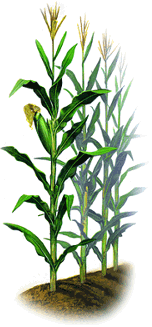
The fact that crabgrass seeds are capable of germinating throughout the hot summer months makes it difficult to achieve long-term control of this problem weed. A recent study in comparing the persistence of certain chloroacetamide herbicides indicated that metolachlor (Bicep, Bicep II, Broadstrike SF+Dual, Dual, and Dual II) dissipated slower relative to acetochlor (Fieldmaster, Fultime, Harness, Harness Extra, Surpass, TopNotch), alachlor (Bullet, Micro-Tech, Partner), or dimethenamid (Frontier, Guardsman, LeadOff). Since the half-lives of the herbicides examined in this study did not exceed 14 days, it is unlikely that any of them are capable of providing full-season crabgrass control.
Because soil-residual herbicides are not able to last throughout the season, it is important to rely on shading of the row middles to extend crabgrass control. If corn growth is limited or stunted from such things as dry weather or herbicide injury, sunlight may reach the row middles and encourage crabgrass growth.
Postemergence applications of atrazine before corn exceeds 12 inches tall may provide temporary control crabgrass plants up to 2-leaf stage. The use of crop oil concentrate instead of a nonionic surfactant as an additive with atrazine is recommended for postemergence control of crabgrass. When using atrazine in sequential treatments such as a postemergence spray followed by a preemergence spray, it is important not exceed the total of 2.5 lbs ai of atrazine per acre per year.
Postemergence applications of certain products containing nicosulfuron (Accent Gold or Basis Gold) can sometimes aid in controlling emerged crabgrass plants. Crabgrass plants need to be small (« to 1" tall depending on product). Since these treatments are more effective in controlling large crabgrass than smooth crabgrass, identification is critical. Large crabgrass has hairs on upper and lower surfaces of leaf blades and sheaths compared with smooth crabgrass which does not have hairs on the leaf blades or sheaths but may have a few hairs near the collar region where the leaf blade wraps around the stem.
Other options for controlling emerged crabgrass include applying Roundup Ultra in Roundup Ready corn or Poast Plus in Poast Protected corn. It is imperative that the herbicide be applied only to hybrids with known resistance.
Sometimes a soil-applied herbicide treatment may be delayed due to weather conditions and other factors. In these situations, such as excessive rainfall, the crop may have emerged before a soil residual herbicide can be applied. The following table outlines the maximum corn and weed size for use of soil-applied herbicide products in corn.
Many of these soil-applied herbicides do not control emerged weeds; thus, to obtain effective weed control a postemergence herbicide may also be needed. Consult the product label for specific guidelines, labeled tank mixtures, precautions, or other limitations.
MAXIMUM CORN AND WEED SIZES FOR SOIL-APPLIED HERBICIDES.
| HERBICIDE | CORN SIZE | WEED SIZE |
| Atrazine | 12 inches | 1.5 inches |
| Axiom | before corn emerges | before emergence |
| Balance | before corn emerges | before emergence |
| Bicep II or Bicep II Magnum | 5 inches | 2-leaf stage |
| Broadstrike SF+ Dual | before corn emerges | before emergence |
| Bullet | 5 inches | 1.5 inches |
| Dual II or Dual II Magnum | 5 inches | before emergence |
| Frontier | 8 inches | before emergence |
| FulTime | 11 inches | before emergence |
| Guardsman | 8 inches | 1.5 inches |
| Harness | 11 inches | before emergence |
| Harness Xtra | 11 inches | 2-leaf stage |
| LeadOff | 8 inches | 1.5 inches |
| Micro-Tech | 5 inches | before emergence |
| Prowl | 4 leaf stage | before emergence |
| Princep | before corn emerges | before emergence |
| Python | 2 inches | before emergence |
| Surpass EC | 11 inches | before emergence |
| TopNotch | 11 inches | before emergence |

Speckled leaf blotch, caused by the fungus Septoria tritici, is much more evident in Kentucky wheat fields than is usual for this time of year. This disease is initially evident as small rectangular lesions which tend to be limited by the leaf veins. Later, lesions expand into irregular shapes and will contain numerous, small, slightly off-round, black, spore-bearing structures called pycnidia. Mature pycnidia are evident with the naked eye, especially in the morning when the leaves are wet. If you hold infected leaves up towards the sky and view them with a 10X lens, the pycnidia will look like slightly flattened miniature car tires. You may also see structures of a similar size and shape, but they will appear greenish because they are mostly colorless; these are immature pycnidia which will eventually turn black.
Almost every field, every year, has low levels of speckled leaf blotch in early- to mid-April, but usually by early-May warm weather shuts the disease down and Stagonospora leaf and glume blotch levels begin to increase. This year, however, speckled leaf blotch is continuing to develop in most fields and Stagonospora levels are low to very low. I suspect this situation will change as temperatures continue to warm and at some point, Stagonospora leaf and glume blotch levels will increase as speckled leaf blotch levels off. However, regardless of which disease is active, loss of green leaf tissue which supports yield is reason for concern. Thus, if your wheat crop is not yet flowering, it is important to scout your fields now and assess the possibility that a fungicide application should be made. The key is to avoid significant disease on the top two leaves (and the heads of plants in the case of Stagonospora) . Disease below the second leaf will have little yield impact, but those infections serve as a "red flag" for possible later infections on the upper leaves.
For crops in the flowering to post-flowering stages, your fungicide options are limited to mancozeb,which can help with Septoria and Stagonospora, but it is not the active ingredient of choice for a variety of different reasons. In any event, most research to date indicates that fungicides applied after crop flowering are rarely economical. Fungicide application days-to-harvest restrictions usually help farmers "decide" when it is too late to make a fungicide application anyway.
Several potential pests were reported to be active in wheat last week. All three are common to Kentucky wheat fields every year, so finding them should be no surprise. The real question is whether or not their populations will become large enough to warrant a treatment. Just because a pest is present does not mean that you can justify an insecticide application to get rid of them.
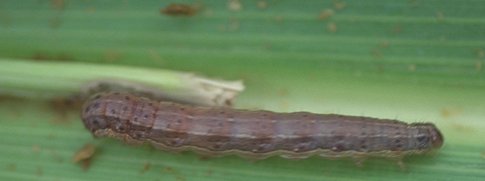 Armyworms are very common and will be found in
most wheat fields. However, because they are so
heavily attacked by natural enemies, they rarely
reach economic levels. Armyworms are always a
threat, so checking your fields until the wheat is
physiologically mature is important. You need to
protect the Flag and F1 leaves.
Armyworms are very common and will be found in
most wheat fields. However, because they are so
heavily attacked by natural enemies, they rarely
reach economic levels. Armyworms are always a
threat, so checking your fields until the wheat is
physiologically mature is important. You need to
protect the Flag and F1 leaves.

Cereal leaf beetle problems usually are very sporadic. It is not as common as the armyworm but generally is found in all of Kentucky's small grain growing areas. These populations can be very intense. It is common to find a particularly bad problem in one field while a nearby field has no problem. Be sure to protect the Flag and F1 leaves.
The are still a lot of questions about the two aphid
species still present in our wheat fields. You should
be most concerned about the light green or light
brown aphid that usually appears in the heads.

This is the English grain aphid (EGA) which can cause yield reductions by feeding on grain heads.
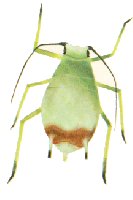
We are still seeing some Bird Cherry-Oat aphids (BCOA). This darker aphid is usually found down on the foliage of the plant. As the weather warms the BCOA will go away and the EGA may increase. No matter which aphid you see, it is the head feeding with which you are now concerned.
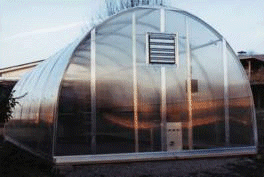
There is a lot of misunderstanding about what types of pesticides can be used to control insects and mites on greenhouse vegetables. The confusion revolves around vegetable transplants grown in the greenhouse. Are vegetable transplants that are only grown for a short period of time considered greenhouse vegetables? The answer is yes, it is a greenhouse vegetable. What if the plants are removed long before flowering and fruit formation begins? It doesn't matter, they are still greenhouse vegetables and are considered the same as plants that remain in the greenhouse for fruiting.
What this means is that we have very few tools in our chemical tool box to control insects and mites on greenhouse vegetables grown for transplants. In short, we have the Bacillus thuringiensis sprays to control lepidopterous pests, some neem products, insecticidal soap, some pyrethrin products, and horticultural oils to control insect and mite pests. We do not have the tools for effective rescue treatments when a crisis occurs. Knowing this, the strategy we must follow is reliance on preventive cultural controls. Here are some of the necessary cultural controls that need to be used with greenhouse vegetables:
Begin vegetable transplants in greenhouses that are empty. Vegetables should not be started where other plants are present, because these other plants will harbor pests that readily move to vegetables. By starting transplants only in empty greenhouses, we should be relatively pest-free at the start at least.
Allow the greenhouse to freeze before starting vegetable transplants. This eliminates tender insects such as whiteflies and some thrips.
Keep the greenhouse free of weeds before and throughout transplant production. Not only do weeds harbor thrips, aphids, mites, and whiteflies, but they also can be the source of viruses and other diseases. Weeds around the outside of the greenhouse should be eliminated or mowed regularly as well.
Keep doors, screens and ventilators in good repair. While popular, greenhouses with sidewalls that can be opened for ventilation allow for easy pest entry into the greenhouse. Screens over ventilators can be used to reduce insect entry.
Keep the greenhouse clean. Eliminate pools of standing water on floors. Algal and moss growth in these areas can be sources of fungus gnat and shore fly problems. Dispose of trash, boards and old plant debris in the area.
Avoid over watering and promote good ventilation to minimize wet areas conducive to fly breeding.
Avoid wearing brightly colored or yellow clothing which is attractive to many insect pests.
Use colored sticky cards to monitor for thrips, aphids, whiteflies, fungus gnats, and shore flies. Plants should be examined for these and other pests at least twice per week. In particular, examine underneath leaves and the growing points closely. We just don't have tools that can effectively salvage a crop when pests are allowed to develop to high levels.
Of the more than 600 types of plants susceptible to crown gall disease, perhaps the most damaged are the fruit crops. Crown gall disease is especially devastating to grapes in Kentucky, but it can also affect apples, stone fruits, and brambles.
Symptoms. The disease is characterized by galls or knobby overgrowths that form on susceptible plant tissues.
Grapes. Galls develop following an injury permitting entrance of the pathogen and may appear on the roots, trunk, and arms of grape vines. Such injuries may occur during intermittent freezing and thawing weather common to Kentucky each winter. Vitis vinifera grape cultivars are more susceptible than V. labrusca. The bacteria can live systemically inside the grapevines, and sometimes, galls may not develop until after the grapes are injured.
Apples and stone fruits. Galls form on the roots and crowns of the trees. They are often located at pruning wounds. Apple rootstocks M.7, M.9, and M.26 are the most susceptible.
Brambles. The lower canes of brambles are affected by crown gall and a related disease called cane gall. Sometimes infected canes become weakened and break. The disease may have little impact on plant growth and production or may cause complete death. Black and purple raspberries are more often affected than red raspberries or blackberries.
New galls first appear in early summer as white, fleshy, callus growth. Galls turn brown by late summer and in the fall become dry and corky. The woody tumors may be gnarled with rough surfaces. Galls can develop rapidly and completely girdle a young plant in one season, or they may take a few years to develop. When galls are numerous or when they are located on the major roots or on the root crown, they disrupt the translocation of water and mineral elements, leading to poor growth, gradual dieback, and sometimes death of vines, trees, or canes. In general, affected plants are more susceptible to adverse environmental conditions, especially winter injury.
Cause and biology of the disease. Crown gall is caused by the soil-borne bacterium, Agrobacterium tumefaciens (cane gall of brambles, by Agrobacterium rubi). The bacterium survives for long periods of time in soil, and also in galls and in diseased plants. A fresh wound is required for infection and gall formation to begin; such injuries may include those caused by pruning, budding and grafting, cultivation, harvesting, insect feeding, or freezing temperatures. Overwintering bacteria may be spread to wound sites by splashing rain, running water, on cultivation implements or on pruning tools. Contaminated nursery stock may be another source of the disease. The bacteria can survive in the soil for many years.
Disease management.
Select planting sites with no history of crown gall, or wait at least 5 years before replanting such sites.
Plant only certified, disease-free nursery stock; discard plants with galls.
Minimize root injuries during planting.
Reduce freeze injury by careful site selection and use of cold-tolerant cultivars.
Plant vines, trees, and canes in well-drained soil.
Adopt management practices that minimize wounding.
Hill up soil around grapevines or otherwise protect the lower trunk in fall to reduce winter injury and resulting wound sites needed for infection.
Remove and destroy infected plants.
Galls can sometimes be pruned out.
A microbial antagonist, or biological control such as Norbac 84 or Galltrol, may be effective for stone fruits, but not for apples or grapes. These biocontrol agents must be applied before trees are transplanted into the orchard.
Soil fumigation is generally not effective for destroying the pathogen.

Euonymus scale

Euonymus scale is the most damaging pest of euonymus in urban landscapes. The grayish females infest mainly the stems and twigs; the whitish males settle mainly on the leaves. The scales suck juices from their host plants causing dieback, chlorosis, and leaf drop. The vulnerable crawler stage of this pest is hatching now. Watch for the tiny yellowish crawlers (visible with a 10x hand lens) emerging and creeping over the vegetation. Another way to spot the crawlers is to tap the vegetation over a sheet of white paper. If warranted, treat with 2 percent horticultural oil, insecticidal soap, or a conventional insecticide when crawlers are first noticed. Repeat the application after 7-10 days.
Dogwood Borer

The dogwood borer is the most serious pest of ornamental dogwoods, especially stressed trees in full sun. Borers rarely injure healthy trees or shrubs growing in their natural environments. When transplanted into landscape settings, every effort should be made to minimize plant stresses such as drought, soil compaction, sun scald, soil compaction, lawn mower/weed trimmer injuries, etc. Because newly planted trees are under considerable stress, preventive sprays are advisable during the first couple of growing seasons after planting.
As with other borer species, timing is crucial in order to have a lethal residue of insecticide on the bark to intercept newly-hatched larvae before they burrow into the tree. Now is the appropriate time to apply protectant sprays. Lindane or Dursban are effective, and should be sprayed to runoff on the trunk and main scaffold limbs. A second application, three weeks after the first one, provides extended protection.
Potato leafhopper
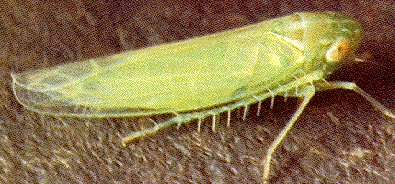 Potato leafhopper infestations are beginning on maples. Leafhoppers migrate into
Kentucky each spring on prevailing winds from the
south. The small, green insects feed on the
undersides of young expanding leaves, injecting
toxic saliva. They are a particularly severe problem
in nurseries, causing curling, cupping, stunting, and
browning of leaf margins. Growth is reduced and
the beauty and symmetry of the tree is eventually
affected. Red maples are highly susceptible, sugar
maples somewhat less susceptible, and Norway
maples are relatively resistant.
Potato leafhopper infestations are beginning on maples. Leafhoppers migrate into
Kentucky each spring on prevailing winds from the
south. The small, green insects feed on the
undersides of young expanding leaves, injecting
toxic saliva. They are a particularly severe problem
in nurseries, causing curling, cupping, stunting, and
browning of leaf margins. Growth is reduced and
the beauty and symmetry of the tree is eventually
affected. Red maples are highly susceptible, sugar
maples somewhat less susceptible, and Norway
maples are relatively resistant.
Commercial nurseries and landscape managers can prevent damage from this important pest by spraying the foliage 2 or 3 times at two week intervals, beginning now. Synthetic pyrethroids (e.g., Tempo, Talstar, Scimitar) provide excellent control; Orthene, Dursban and Sevin are also effective. Although potato leafhopper is a serious pest in commercial nurseries, control is not usually warranted for homeowners.
 Eastern tent caterpillars have been very abundant
this spring. They have been completely defoliating
wild cherry in some areas and moving off to finish
their feeding on other plants. Most larvae are
mature now and enter a wandering stage that leads
them away from their host tree and to a protected
area where they can pupate and metamorphose to
the adult or moth stage.
Eastern tent caterpillars have been very abundant
this spring. They have been completely defoliating
wild cherry in some areas and moving off to finish
their feeding on other plants. Most larvae are
mature now and enter a wandering stage that leads
them away from their host tree and to a protected
area where they can pupate and metamorphose to
the adult or moth stage.
A parade of large, hairy caterpillars that move up the sides of houses and onto decks and outdoor living spaces does not please most home owners. To add insult to injury, the caterpillars are generally totally unresponsive to direct applications of insecticides. While they may eventually die, lack of a sudden fatal response also frustrates the homeowner. Mechanical control of the larvae is probably the best way to deal with them. A stiff broom can be used to sweep them up for disposal.

Ground beetles were a common site in samples submitted for identification last week. These small (1/2 inch long) black beetles are attracted to lights at night and dozens to hundreds may enter homes or buildings.
Adults may wander into homes by crawling through small openings or under doors. They will not stay inside-they prefer the outdoors. Since ground beetles are beneficial insects, control is not warranted. However, if they are creating a nuisance, move or remove hiding places next to the house such as log piles, mulch, and debris around the perimeter. Caulking and weatherstripping will close some entrance points. Beetles found indoors may be swept up and discarded. If beetles are creating a nuisance by flying to lights at night, repositioning the lighting or changing white lights to yellow may reduce the attraction.
The field crop situation has changed little over the past week with barley yellow dwarf virus as the main disease seen on wheat and Pythium root rot the main disease problem currently on tobacco float plants. A few cases of target spot were also seen on tobacco, as were nutritional and chemical problems.
On small fruits we have seen "mummy berry" (Monilinia) of blueberry and Mycosphaerella leaf spot of strawberry.
On ornamentals we have seen anthracnose of ash and brown spot (Mycosphaerella) of pine in the landscape; we have also diagnosed blossom blight (Botrytis) of petunia and bacterial blight (Xanthomonas) of geranium in greenhouse production.
On greenhouse-grown vegetable transplants, we diagnosed tomato mosaic virus in both tomato and pepper.

| UKREC-Princeton, KY, April 30 - May 7 | |
| True Armyworm | 17 |
| Black Cutworm | 3 |
Lee Townsend
Extension Entomologist